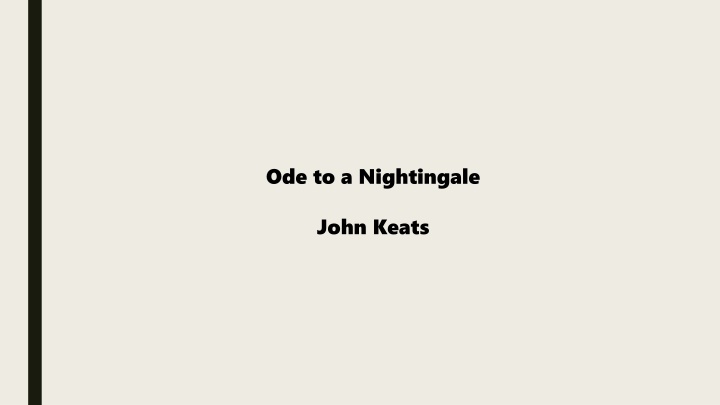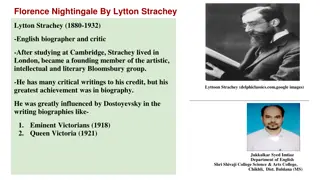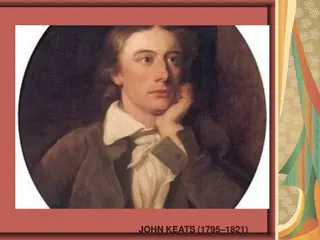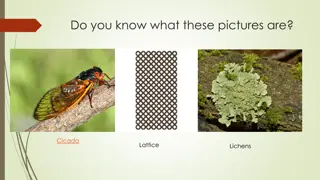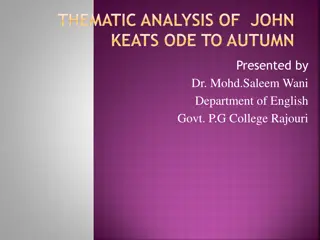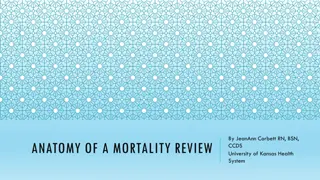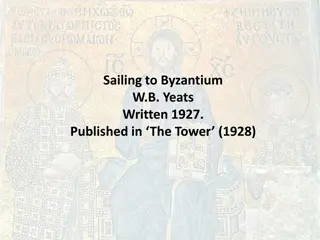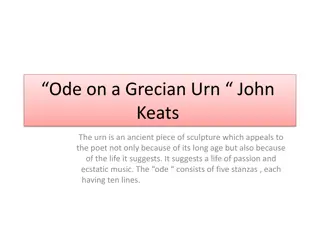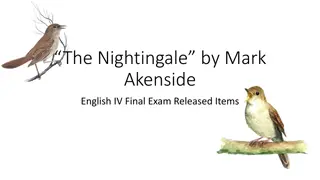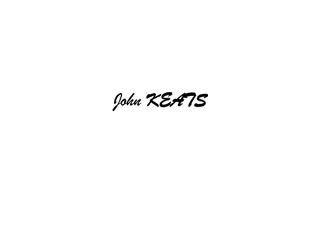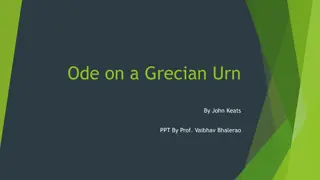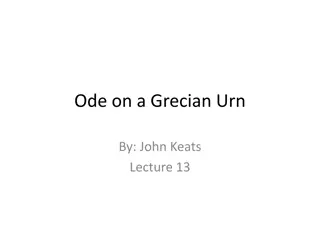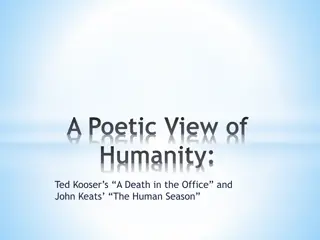Themes of Mortality and Transcendence in Keats' "Ode to a Nightingale
Keats' "Ode to a Nightingale" explores themes of poetic inspiration, the escapism of art, and the inevitability of death. The poet grapples with the contrast between the timeless beauty of the nightingale's song and the fleeting nature of human existence, contemplating the transient nature of life and the desire for immortality through art.
Download Presentation

Please find below an Image/Link to download the presentation.
The content on the website is provided AS IS for your information and personal use only. It may not be sold, licensed, or shared on other websites without obtaining consent from the author.If you encounter any issues during the download, it is possible that the publisher has removed the file from their server.
You are allowed to download the files provided on this website for personal or commercial use, subject to the condition that they are used lawfully. All files are the property of their respective owners.
The content on the website is provided AS IS for your information and personal use only. It may not be sold, licensed, or shared on other websites without obtaining consent from the author.
E N D
Presentation Transcript
Ode to a Nightingale John Keats
THEMATIC CONCERN The rapture of poetic inspiration matches the endless creative rapture of the nightingale s music and lets the speaker, in stanzas five through seven, imagine himself with the bird in the darkened forest. The ecstatic music even encourages the speaker to embrace the idea of dying, of painlessly succumbing to death while enraptured by the nightingale s music and never experiencing any further pain or disappointment. But when his meditation causes him to utter the word forlorn, he comes back to himself, recognizing his fancy for what it is an imagined escape from the inescapable ( Adieu! the fancy cannot cheat so well / As she is fam d to do, deceiving elf ). As the nightingale flies away, the intensity of the speaker s experience has left him shaken, unable to remember whether he is awake or asleep.
THEMATIC CONCERNS In Indolence, the speaker rejected all artistic effort. In Psyche, he was willing to embrace the creative imagination, but only for its own internal pleasures. But in the nightingale s song, he finds a form of outward expression that translates the work of the imagination into the outside world, and this is the discovery that compels him to embrace Poesy s viewless wings at last. The art of the nightingale is endlessly changeable and renewable; it is music without record, existing only in a perpetual present. As befits his celebration of music, the speaker s language, sensually rich though it is, serves to suppress the sense of sight in favor of the other senses. He can imagine the light of the moon, But here there is no light ; he knows he is surrounded by flowers, but he cannot see what flowers are at his feet. This suppression will find its match in Ode on a Grecian Urn, which is in many ways a companion poem to Ode to a Nightingale. In the later poem, the speaker will finally confront a created art-object not subject to any of the limitations of time; in Nightingale, he has achieved creative expression and has placed his faith in it, but that expression the nightingale s song is spontaneous and without physical manifestation.
THE INEVITABILITY OF DEATH Even before his diagnosis of terminal tuberculosis, Keats focused on death and its inevitability in his work. For Keats, small, slow acts of death occurred every day, and he chronicled these small mortal occurrences. The end of a lover s embrace, the images on an ancient urn, the reaping of grain in autumn all of these are not only symbols of death, but instances of it. Examples of great beauty and art also caused Keats to ponder mortality, as in On Seeing the Elgin Marbles (1817). As a writer, Keats hoped he would live long enough to achieve his poetic dream of becoming as great as Shakespeare or John Milton: in Sleep and Poetry (1817), Keats outlined a plan of poetic achievement that required him to read poetry for a decade in order to understand and surpass the work of his predecessors. Hovering near this dream, however, was a morbid sense that death might intervene and terminate his projects; he expresses these concerns in the mournful 1818 sonnet When I have fears that I may cease to be.
THE CONTEMPLATION OF BEAUTY In his poetry, Keats proposed the contemplation of beauty as a way of delaying the inevitability of death. Although we must die eventually, we can choose to spend our time alive in aesthetic revelry, looking at beautiful objects and landscapes. Keats s Speakers contemplate urns ( Ode on a Grecian Urn ), books ( On First Looking into Chapman sHomer [1816], On Sitting Down to Read King Lear Once Again [1818]), birds ( Ode to a Nightingale ), and stars ( Bright star, would I were stedfast as thou art [1819]). Unlike mortal beings, beautiful things will never die but will keep demonstrating their beauty for all time. Keats explores this idea in the first book of Endymion (1818). The speaker in Ode on a Grecian Urn envies the immortality of the lute players and trees inscribed on the ancient vessel because they shall never cease playing their songs, nor will they ever shed their leaves. He reassures young lovers by telling them that even though they shall never catch their mistresses, these women shall always stay beautiful. The people on the urn, unlike the speaker, shall never stop having experiences. They shall remain permanently depicted while the speaker changes, grows old, and eventually dies.
DEPARTURES AND REVERIES In many of Keats s poems, the speaker leaves the real world to explore a transcendent, mythical, or aesthetic realm. At the end of the poem, the speaker returns to his ordinary life transformed in some way and armed with a new understanding. Often the appearance or contemplation of a beautiful object makes the departure possible. The ability to get lost in a reverie, to depart conscious life for imaginative life without wondering about plausibility or rationality, is part of Keats s concept of negative capability. In Bright star, would I were stedfast as thou art, the speaker imagines a state of sweetunrest (12) in which he will remain half-conscious on his lover s breast forever. As speakers depart this world for an imaginative world, they have experiences and insights that they can then impart into poetry once they ve returned to conscious life. Keats explored the relationship between visions and poetry in Ode to Psyche and Ode to a Nightingale.
THE FIVE SENSES AND ART Keats imagined that the five senses loosely corresponded to and connected with various types of art. The speaker in Ode on a Grecian Urn describes the pictures depicted on the urn, including lovers chasing one another, musicians playing instruments, and a virginal maiden holding still. All the figures remain motionless, held fast and permanent by their depiction on the sides of the urn, and they cannot touch one another, even though we can touch them by holding the vessel. Although the poem associates sight and sound, because we see the musicians playing, we cannot hear the music. Similarly, the speaker in On First Looking into Chapman sHomer compares hearing Homer s words to pureserene (7) air so that reading, or seeing, becomes associating with breathing, or smelling. In Ode to a Nightingale, the speaker longs for a drink of crystal-clear water or wine so that he might adequately describe the sounds of the bird singing nearby. Each of the five senses must be involved in worthwhile experiences, which, in turn, lead to the production of worthwhile art
THE DISAPPEARANCE OF THE POET AND THE SPEAKER In Keats s theory of negative capability, the poet disappears from the work that is, the work itself chronicles an experience in such a way that the reader recognizes and responds to the experience without requiring the intervention or explanation of the poet. Keats s speakers become so enraptured with an object that they erase themselves and their thoughts from their depiction of that object. In essence, the speaker/poet becomes melded to and indistinguishable from the object being described. For instance, the speaker of Ode on a Grecian Urn describes the scenes on the urn for several stanzas until the famous conclusion about beauty and truth, which is enclosed in quotation marks. Since the poem s publication in 1820, critics have theorized about who speaks these lines, whether the poet, the speaker, the urn, or one or all the figures on the urn. The erasure of the speaker and the poet is so complete in this particular poem that the quoted lines are jarring and troubling.
MUSIC AND MUSICIANS Music and musicians appear throughout Keats s work as Symbols of poetry and poets. In Ode on a Grecian Urn, for instance, the speaker describes musicians playing their pipes. Although we cannot literally hear their music, by using our imaginations, we can imagine and thus hear music. The speaker of ToAutumn reassures us that the season of fall, like spring, has songs to sing. Fall, the season of changing leaves and decay, is as worthy of poetry as spring, the season of flowers and rejuvenation. Ode to a Nightingale uses the bird s music to contrast the mortality of humans with the immortality of art. Caught up in beautiful birdsong, the speaker imagines himself capable of using poetry to join the bird in the forest. The beauty of the bird s music represents the ecstatic, imaginative possibilities of poetry. As mortal beings who will eventually die, we can delay death through the timelessness of music, poetry, and other types of art
NATURE Like his fellow Romantic poets, Keats found in nature endless sources of poetic inspiration, and he described the natural world with precision and care. Observing elements of nature allowed Keats, Wordsworth, Coleridge, and Shelley, among others, to create extended meditations and thoughtful odes about aspects of the human condition. For example, in Ode to a Nightingale, hearing the bird s song causes the speaker to ruminate on the immortality of art and the mortality of humans. The speaker of Ode on Melancholy compares a bout of depression to a weepingcloud (12), then goes on to list specific flowers that are linked to sadness. He finds in nature apt images for his psychological state. In Ode to Psyche, the speaker mines the night sky to find ways to worship the Roman goddess Psyche as a muse: a star becomes an amorous glow-worm (27), and the moon rests amid a background of dark blue. Keats not only uses nature as a springboard from which to ponder, but he also discovers in nature Similes, symbols, and Metaphors for the spiritual and emotional states he seeks to describe
THE ANCIENT WORLD Keats had an enduring interest in antiquity and the ancient world. His longer poems, such as The Fall of Hyperion or Lamia, often take place in a mythical world not unlike that of classical antiquity. He borrowed figures from ancient mythology to populate poems, such as Ode to Psyche and To Homer (1818). For Keats, ancient myth and antique objects, such as the Grecian urn, have a permanence and solidity that contrasts with the fleeting, temporary nature of life. In ancient cultures, Keats saw the possibility of permanent artistic achievement: if an urn still spoke to someone several centuries after its creation, there was hope that a poem or artistic object from Keats s time might continue to speak to readers or observers after the death of Keats or another writer or creator. This achievement was one of Keats s great hopes. In an 1818 letter to his brother George, Keats quietly prophesied: I think I shall be among the English poets after my death.
